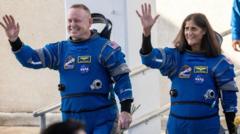When NASA astronauts Suni Williams and Butch Wilmore found themselves approaching the International Space Station (ISS) in June 2024 aboard their Boeing Starliner capsule, they encountered a dire situation with failing thrusters. With uncertainty looming, they realized that without successful docking, their chances of returning to Earth were slim. "If we weren't able to dock, would we be able to make it back? We didn't know," Mr. Wilmore recounted in an interview two months after their successful return.
Originally slated for an eight-day mission, the astronauts ultimately spent nearly 10 months in orbit. The initial mission complication arose from their inability to dock at the ISS due to technical problems; however, with mission control's guidance, they managed to restart the thrusters and successfully connect with the ISS shortly thereafter.
The emotional pressure during these moments was palpable. "The possibility they might never see Earth again certainly crossed our minds," Mr. Wilmore acknowledged. Yet, the duo refrained from voicing their worst fears, driven instead by their training to focus on problem-solving. "We sort of read each other's mind," Ms. Williams added. "These were not expected... but we quickly focused on what we had and what we could do."
After months of experiments aboard the space station, the pair's predicament took a turn when Boeing deemed the risks of their spacecraft unsafe for the journey home. Consequently, the astronauts were repatriated aboard a SpaceX capsule, highlighting a notable collaboration in commercial spaceflight. While Boeing maintained that the Starliner was an effective vessel, both astronauts acknowledged their appreciation for the safety nets in place at the ISS.
The political narrative gained traction as President Trump criticized President Biden for “abandoning” the mission, but both astronauts insisted they remained focused on their scientific objectives rather than political debates. "We can't speak to that at all," said Mr. Wilmore, emphasizing the challenges of human spaceflight.
Following their triumphant return on March 18, the pair revealed their focus on maintaining fitness throughout their ordeal in zero gravity. Mr. Wilmore shared that performing squats and deadlifts continuously for nine months made him "literally stronger than I've ever been in my life." However, he and Ms. Williams acknowledged the challenges of readjusting to gravity, likening it to a painful yet familiar experience.
In the aftermath of their return, Williams and Wilmore have been actively collaborating with NASA and Boeing on troubleshooting issues with the Starliner. Both expressed confidence in its potential, with Mr. Wilmore stating, "We are very positively hopeful that there will be opportunities to fly the Boeing Starliner in the future."
With their remarkable journey packed with trials and growth, the astronauts confirmed their willingness to fly aboard the Starliner once issues are resolved, reaffirming its worthiness for future space missions. "It's a very capable spacecraft; it has unique capabilities that are great for future astronauts to fly," Ms. Williams stated optimistically.

















